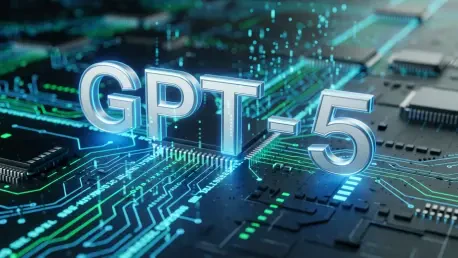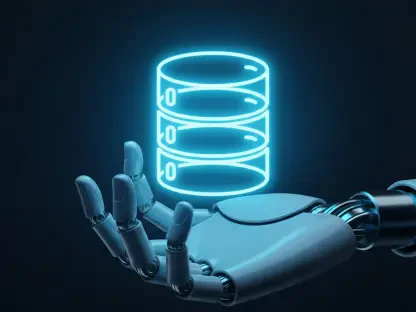Unveiling the Future of Coding with GPT-5
Imagine a world where software development, once a labor-intensive craft, becomes as fluid as a conversation, with complex code generated in mere minutes. This is no longer a distant dream but a reality shaped by GPT-5, OpenAI’s latest generative AI model, which is redefining the boundaries of programming. With a staggering capacity to understand and produce intricate code, this technology promises to address the global developer shortage, where demand for skilled professionals continues to outpace supply. This review dives deep into the capabilities of GPT-5, exploring how it transforms the coding landscape and why it stands as a pivotal innovation in the tech industry today.
Core Features and Technological Breakthroughs
Advanced Coding Capabilities through Smart Prompting
GPT-5 elevates coding to an unprecedented level with its refined ability to interpret nuanced instructions through advanced prompting techniques like chain-of-thought reasoning. Unlike earlier models, it dissects complex problems into logical steps, generating code that is not only functional but also optimized for performance. Industry experts have noted its remarkable proficiency in languages ranging from Python to JavaScript, often producing solutions that rival human-written code in clarity and efficiency.
This model’s debugging prowess further sets it apart, as it identifies errors with a precision that surpasses its predecessors. Where older versions might have stumbled over intricate bugs, GPT-5 offers detailed explanations and corrective suggestions, streamlining the development process. Such advancements mark a significant leap, making it a vital tool for developers tackling tight deadlines or intricate projects.
Seamless Integration into Developer Workflows
Another standout feature is GPT-5’s compatibility with popular development environments such as Visual Studio Code. This integration allows coders to access AI assistance directly within their preferred platforms, minimizing disruptions and enhancing workflow efficiency. Early adopters have reported that this synergy reduces the learning curve, enabling teams to incorporate AI support without overhauling existing systems.
Beyond mere compatibility, the model’s ability to adapt to specific project requirements through contextual understanding amplifies its utility. Whether it’s generating boilerplate code or suggesting architectural improvements, GPT-5 embeds itself as a virtual collaborator, reshaping how developers approach daily tasks. This seamless melding with tools hints at a future where AI becomes an invisible yet indispensable part of coding ecosystems.
Performance Analysis in Real-World Scenarios
Productivity Gains Across Industries
In practical applications, GPT-5 demonstrates transformative potential by automating repetitive coding tasks across diverse sectors, from nimble tech startups to sprawling enterprises. Reports indicate significant time savings in areas like web development, where mundane scripting is handled instantly, freeing up human talent for creative problem-solving. This efficiency translates into faster product rollouts, a critical advantage in competitive markets.
Moreover, organizations adopting this technology have documented measurable cost reductions, with some estimating a decrease in development expenses by nearly 40%. By minimizing the need for extensive manual coding, GPT-5 allows firms to allocate resources more strategically, focusing on innovation rather than routine maintenance. Such economic benefits underscore its appeal as a game-changer in resource-strapped environments.
Addressing Complex Challenges with Precision
Despite its strengths, GPT-5 is not without hurdles when faced with highly specialized or multifaceted coding demands. While it excels in standard scenarios, it occasionally struggles with niche requirements that demand deep domain expertise, necessitating human oversight. This limitation highlights the importance of viewing AI as a partner rather than a standalone solution in intricate projects.
Security also emerges as a concern, as AI-generated code may inadvertently introduce vulnerabilities if not rigorously vetted. Ensuring robust validation processes becomes paramount to prevent potential exploits, a challenge that developers must navigate as reliance on such tools grows. These issues, while notable, do not diminish the model’s value but rather emphasize the need for balanced integration strategies.
Market Trends and Competitive Landscape
Rising Tide of AI in Software Development
The integration of AI into coding practices represents a broader trend driven by both technological progress and market necessity. With a persistent shortage of skilled developers, tools like GPT-5 fill critical gaps, enabling even non-experts to contribute to software creation through guided assistance. This democratization of coding skills is reshaping industry dynamics, fostering innovation at an accelerated pace.
Competition among tech giants further fuels this evolution, with entities like Google and Microsoft pushing their own AI coding solutions to rival OpenAI’s offerings. This rivalry drives rapid advancements, ensuring that tools continuously improve in accuracy and functionality. However, it also raises questions about market dominance and accessibility for smaller players who may struggle to keep up with the pace of innovation.
Ethical and Regulatory Considerations
As AI becomes entrenched in development, ethical dilemmas surface, particularly around the risk of biased outputs or over-dependence on automated code. Without proper safeguards, there’s a danger of perpetuating flaws in training data, which could lead to skewed or unfair results in applications. Addressing these concerns requires transparent practices and ongoing vigilance from the tech community.
Regulatory frameworks add another layer of complexity, with policies like the EU AI Act imposing strict guidelines on high-risk AI systems. Compliance with such standards, alongside data privacy laws, poses challenges for widespread adoption, yet it also ensures accountability. Navigating this landscape will be crucial for companies aiming to leverage GPT-5 while maintaining trust and legal adherence.
Final Thoughts on GPT-5’s Impact
Reflecting on this evaluation, GPT-5 proves to be a formidable force in software development, showcasing unparalleled coding abilities and integration potential that reshape productivity benchmarks. Its capacity to streamline workflows and reduce costs leaves a lasting impression, even as challenges around complex tasks and security underscore the need for cautious implementation. Looking ahead, the focus should shift toward refining hybrid models that blend AI precision with human insight, ensuring robust solutions for intricate coding needs. Additionally, fostering industry-wide dialogue on ethical guidelines and regulatory compliance will be essential to maximize benefits while mitigating risks. As the technology evolves, staying attuned to these developments will guide developers and organizations in harnessing GPT-5’s full potential responsibly.









